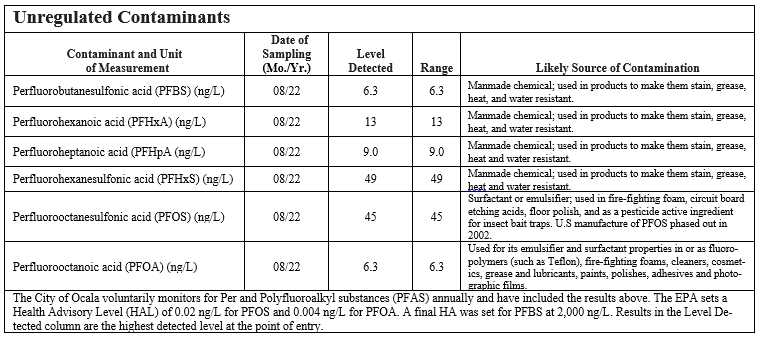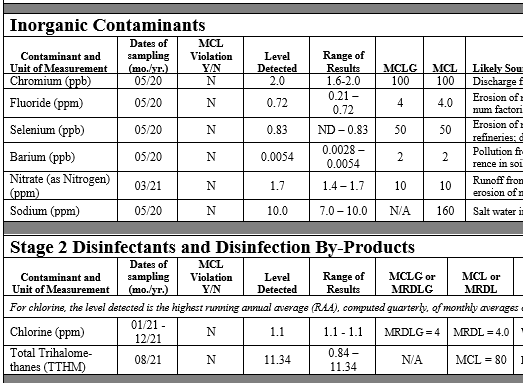BAHIA OAKS WATER SYSTEM
PWS ID# 6420103
We’re very pleased to provide you with this year’s Annual Drinking Water Quality Report.
We want to keep you informed about the excellent water and services we have delivered to you over the past year. Our goal is and always has been, to provide to you a safe and dependable supply of drinking water. Our water is obtained from the City of Ocala, which is produced from ground water from 6 source wells which draw from the Floridan Aquifer, softened, chlorinated for disinfecting purposes, and fluoridated for dental health purposes. If you have any questions about this report or concerning your water utility, please contact us at (352) 245-3475.
Southwest Ocala Utility, Inc. and the City of Ocala routinely monitor for contaminants in your drinking water according to Federal and State laws, rules, and regulations. Except where indicated otherwise, this report is based on the results of monitoring for the period of January 1 to December 31, 2022. Data obtained before January 1, 2022 and presented in this report are from the most recent testing done in accordance with the laws, rules, and regulations.
We constantly monitor for various contaminants in the water supply to meet all regulatory requirements. As you can see by the table, our water system had no maximum contaminant level violations. We are proud that your drinking water meets or exceeds all Federal and State requirements. While we have learned through our monitoring and testing that some constituents have been detected, the presence of some contaminants does not necessarily indicate that the water poses a health risk.
In 2022, the Florida Department of Environmental Protection (FDEP) performed a Source Water Assessment on the City of Ocala system (PWS ID# 342-0922). The assessment was conducted to provide information about any potential sources of contamination in the vicinity of their wells. There are 39 unique potential sources of contamination identified for their system with low to moderate susceptibility levels. The assessment results are available on the FDEP Source Water Assessment and Protection Program (SWAPP) website at https://prodapps.dep.state.fl.us/swapp/
The sources of drinking water (both tap water and bottled water) include rivers, lakes, streams, ponds, reservoirs, springs, and wells. As water travels over the surface of the land or through the ground, it dissolves naturally occurring minerals and, in some cases, radioactive material, and can pick up substances resulting from the presence of animals or from human activity.
Contaminants that may be present in source water include:
(A) Microbial contaminants, such as viruses and bacteria, which may come from sewage treatment plants, septic systems, agricultural livestock operations, and wildlife.
(B) Inorganic contaminants, such as salts and metals, which can be naturally-occurring or result from urban stormwater runoff, industrial or domestic wastewater discharges, oil and gas production, mining, or farming.
(C) Pesticides and herbicides, which may come from a variety of sources such as agriculture, urban stormwater runoff, and residential uses.
(D) Organic chemical contaminants, including synthetic and volatile organic chemicals, which are by-products of industrial processes and petroleum production, and can, also come from gas stations, urban stormwater runoff, and septic systems.
(E) Radioactive contaminants, which can be naturally occurring or be the result of oil and gas production and mining activities.
Some people may be more vulnerable to contaminants in drinking water than the general population. Immuno-compromised persons such as persons with cancer undergoing chemotherapy, persons who have undergone organ transplants, people with HIV/AIDS or other immune system disorders, some elderly, and infants can be particularly at risk from infections. These people should seek advice about drinking water from their health care providers. EPA/CDC guidelines on appropriate means to lessen the risk of infection by Cryptosporidium and other microbiological contaminants are available from the Safe Drinking Water Hotline (800-426-4791).
If present, elevated levels of lead can cause serious health problems, especially for pregnant women and young children. Lead in drinking water is primarily from materials and components associated with service lines and home plumbing. Southwest Ocala Utility, Inc. is responsible for providing high quality drinking water, but cannot control the variety of materials used in plumbing components. When your water has been sitting for several hours, you can minimize the potential for lead exposure by flushing your tap for 30 seconds to 2 minutes before using water for drinking or cooking. If you are concerned about lead in your water, you may wish to have your water tested. Information on lead in drinking water, testing methods, and steps you can take to minimize exposure is available from the Safe Drinking Water Hotline or at https://www.epa.gov/safewater/lead.
In order to ensure that tap water is safe to drink, the EPA prescribes regulations, which limit the amount of certain contaminants in water provided by public water systems. The Food and Drug Administration (FDA) regulations establish limits for contaminants in bottled water, which must provide the same protection for public health.
Drinking water, including bottled water, may reasonably be expected to contain at least small amounts of some contaminants. The presence of contaminants does not necessarily indicate that the water poses a health risk. More information about contaminants and potential health effects can be obtained by calling the Environmental Protection Agency’s Safe Drinking Water Hotline at 1-800-426-4791
Please DO NOT FLUSH your unused/unwanted medications down toilets or sink drains. More information is available at https://www.dep.state.fl.us/waste/categories/medications/pages/disposal.htm

Availability of Monitoring Data for Unregulated Contaminants
The City of Ocala has sampled for a series of unregulated contaminants. Unregulated contaminants are those that don’t yet have a drinking water standard set by EPA. The purpose of monitoring for these contaminants is to help EPA decide whether the contaminants should have a standard. You have a right to know that these data are available. If you are interested in examining the results, please contact Benjamin Moose at 352-351-6772 or [email protected].

Terms and Abbreviations
In the tables above, you will find terms and abbreviations you might not be familiar with. To help you better understand these terms, we’ve provided the following definitions:
Maximum Contaminant Level (MCL): The highest level of a contaminant that is allowed in drinking water. MCLs are set as close to the MCLGs as feasible using the best available treatment technology.
Maximum Contaminant Level Goal (MCLG): The level of a contaminant in drinking water below which there is no known or expected risk to health. MCLGs allow for a margin of safety.
Action Level (AL): The concentration of a contaminant which, if exceeded, triggers treatment or other requirements which a water system must follow.
Parts per million (ppm) or Milligrams per liter (mg/l) – one part by weight of analyte to 1 million parts by weight of the water sample.
Parts per billion (ppb) or Micrograms per liter (µg/l) – one part by weight of analyte to 1 billion parts by weight of the water sample.
Parts per trillion (ppt) or Nanograms per liter (ng/l) – one part by weight of analyte to 1 billion parts by weight of the water sample.
Maximum residual disinfect-ant level (MRDL) – The highest level of a disinfectant allowed in drinking water. There is convincing evidence that addition of a disinfectant is necessary for control of microbial contaminants.
Maximum residual disinfect-ant level goal (MRDLG) – The level of a drinking water disinfectant below, which there is no known or expected risk to health. MRDLGs do not reflect the benefits of the use of disinfectants to control microbial contaminants.
Picocurie per liter (pCi/L) – measure of the radioactivity in water.
ND – Not Detected
TT – Treatment Technique – A required process intended to reduce the level of a contaminant in drinking water.
